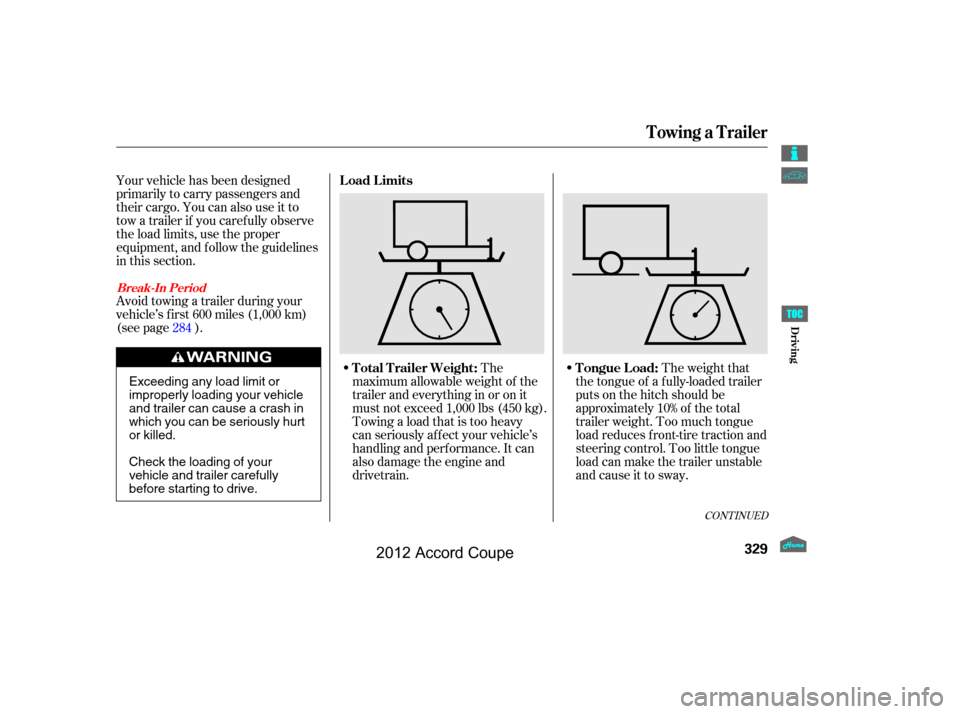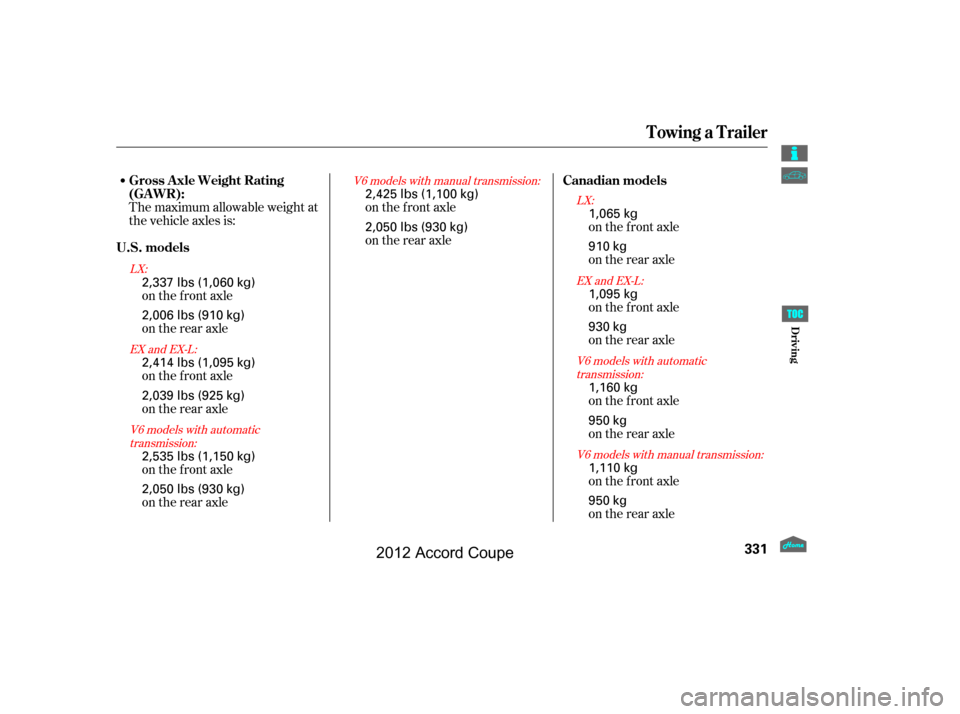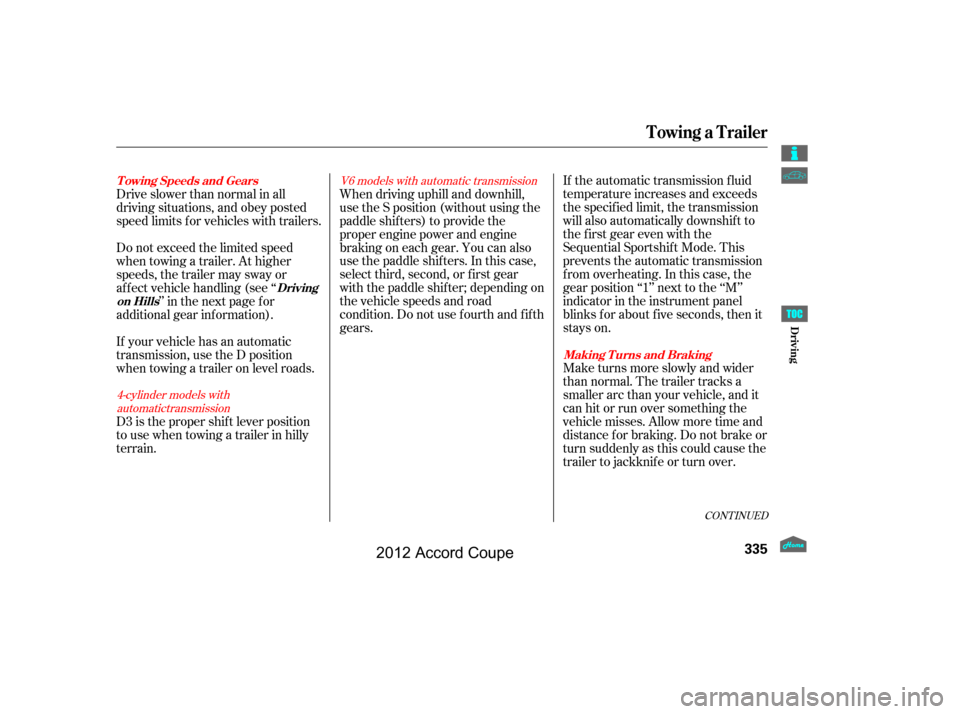HONDA ACCORD COUPE 2012 8.G Owners Manual
Manufacturer: HONDA, Model Year: 2012, Model line: ACCORD COUPE, Model: HONDA ACCORD COUPE 2012 8.GPages: 454, PDF Size: 10.81 MB
Page 331 of 454

As required by the FCC:This device complies with Part 15 of theFCC rules. Operation is subject to thef ollowing two conditions: (1) This devicemay not cause harmf ul interf erence, and(2) this device must accept anyinterf erence received, includinginterf erence that may cause undesiredoperation.
Changes or modif ications not expresslyapproved by the party responsible f orcompliance could void the user’sauthority to operate the equipment.
This device complies with IndustryCanada Standard RSS-210.Operation is subject to the f ollowing twoconditions: (1) this device may not causeinterf erence, and (2) this device mustaccept any interf erence that may causeundesired operation of the device.
If you have a f lat tire, the low tire
pressure indicator will come on.
Replace the flat tire with the
compact spare tire (see page ).
Each wheel (except the compact
sparetirewheel)isequippedwitha
tire pressure sensor. You must use
TPMS specif ic wheels. It is
recommended that you always have
your tires serviced by your dealer or
qualif ied technician. The low tire pressure indicator or
the TPMS indicator will go off, after
several miles (kilometers) driving,
when you replace the spare tire with
the specif ied regular tire equipped
with the tire pressure monitor sensor.
Never use a puncture-repairing agent
in a f lat tire. If used, you will have to
replace the tire pressure sensor.
Havetheflattirerepairedbyyour
dealer as soon as possible.
After you replace the flat tire with
thecompactsparetire,thelowtire
pressure indicator stays on. This is
normal; the system is not monitoring
the spare tire pressure. Manually
check the spare tire pressure to be
sure it is correct. Af ter several miles
(kilometers) driving with the
compact spare tire, the TPMS
indicator comes on and the low tire
pressure indicator goes of f . 393
Changing a T ire with T PMS
Tire Pressure Monitoring System (TPMS)
328
Driving
2012 Accord Coupe
Page 332 of 454

Your vehicle has been designed
primarily to carry passengers and
their cargo. You can also use it to
tow a trailer if you caref ully observe
the load limits, use the proper
equipment, and f ollow the guidelines
in this section.The
maximum allowable weight of the
trailer and everything in or on it
must not exceed 1,000 lbs (450 kg).
Towing a load that is too heavy
can seriously af f ect your vehicle’s
handling and perf ormance. It can
also damage the engine and
drivetrain. The weight that
the tongue of a f ully-loaded trailer
puts on the hitch should be
approximately 10% of the total
trailer weight. Too much tongue
load reduces front-tire traction and
steering control. Too little tongue
load can make the trailer unstable
and cause it to sway.
Avoid towing a trailer during your
vehicle’s f irst 600 miles (1,000 km)
(see page ).
284
CONT INUED
Load Limits
T otal T railer Weight: T ongue L oad:
Towing a Trailer
Break-In Period
329
Exceeding any load limit or
improperly loading your vehicle
and trailer can cause a crash in
which you can be seriously hurt
or killed.
Check the loading of your
vehicle and trailer carefully
beforestartingtodrive.
Driving
2012 Accord Coupe
Page 333 of 454

To achieve a proper tongue load,
start by loading 60% of the load
toward the front of the trailer and
40% toward the rear, then re-adjust
the load as needed.The maximum allowable weight of
the vehicle, all occupants, all
accessories, all cargo, and the
tongue load is:
EX and EX-L:EX and EX-L:
V6 models with manual transmission:
V6 models with automatic
transmission: V6 models with manual transmission:
V6 models with automatic
transmission:
LX:
LX:
Gross Vehicle Weight Rating
(GVWR): Canadian models
U.S. models
Towing a Trailer
330
4,299 lbs (1,950 kg)
4,409 lbs (2,000 kg)
4,541 lbs (2,060 kg)
4,475 lbs (2,030 kg) 1,970 kg
2,020 kg
2,075 kg
2,040 kg
Driving
2012 Accord Coupe
Page 334 of 454

The maximum allowable weight at
the vehicle axles is:on the f ront axle
on the rear axle
on the f ront axle
on the rear axle
on the f ront axle
on the rear axle on the f ront axle
on the rear axle
on the rear axle on the f ront axle
on the rear axle on the f ront axle
on the rear axle on the f ront axle
on the rear axle
on the f ront axle
EX and EX-L:
EX and EX-L:
V6 models with automatictransmission:
V6 models with manual transmission:
V6 models with automatic
transmission: V6 models with manual transmission:
LX:
LX:
Gross Axle Weight Rating
(GA WR): Canadian models
U.S. models
Towing a Trailer
331
2,006 lbs (910 kg) 2,337 lbs (1,060 kg)
2,414 lbs (1,095 kg)
2,039 lbs (925 kg) 910 kg
930 kg
950 kg
2,050 lbs (930 kg) 2,535 lbs (1,150 kg) 2,050 lbs (930 kg) 2,425 lbs (1,100 kg)
950 kg 1,065 kg
1,095 kg
1,160 kg
1,110 kg
Driving
2012 Accord Coupe
Page 335 of 454

Discuss your needs with your trailer
sales or rental agency, and f ollow the
guidelines in this section. Also make
sure that all equipment is properly
installed and maintained, and that it
meets f ederal, state, province,
territory, and local regulations. Towing can require a variety of
equipment, depending on the size of
your trailer, how it will be used, how
much load you are towing, and
where you tow.
Thebestwaytoconfirmthatall
loads are within limits is to check
them at a public scale. For public
scales in your area, check your local
phone book, or contact your trailer
dealer or rental agency for
assistance.
If you cannot get to a public scale,
you can estimate the total trailer
weight by adding the weight of your
trailer (as quoted by the
manuf acturer) with everything in or
on the trailer.
If you normally pull the same load
each time you tow a trailer, you can
use a suitable scale or a special
tongue load gauge to check the
tongue load the f irst time you set up
a towing combination (a f ully loaded
vehicle and trailer), then recheck the
tongue load whenever the conditions
change. Always use saf ety chains when you
tow a trailer. Make sure the chains
are secured to the trailer and hitch,
and that they cross under the tongue
and can catch the trailer if it
becomes unhitched. Leave enough
slack to allow the trailer to turn
corners easily, but do not let the
chains drag on the ground. Any hitch used on your vehicle must
be properly bolted to the underbody.
Towing a Trailer
T owing Equipment and
A ccessories
Checking L oads
Saf et y Chains
Hitches
332
Driving
2012 Accord Coupe
Page 336 of 454

There are two common types of
trailer brakes: surge and electric.
Surge brakes are common f or boat
trailers, since the brakes will get wet.
If you choose electric brakes, be
sure they are electronically actuated.
Do not attempt to tap into your
vehicle’s hydraulic system. No
matter how successf ul it may seem,
any attempt to attach trailer brakes
to your vehicle’s hydraulic system
will lower braking ef f ectiveness and
create a potential hazard.
Seeyourtrailerdealerorrental
agency f or more inf ormation on
installing electric brakes.Many states and Canadian
provinces/territories require special
outside mirrors when towing a trailer.
Even if they don’t, you should install
special mirrors if you cannot clearly
see behind you, or if the trailer
creates a blind spot.
Trailer lights and equipment must
comply with f ederal, state, province,
territory, and local regulations.
Check with your local trailer sales or
rental agencies f or the requirements
in the area where you plan to tow,
and use only equipment designed f or
your vehicle.
Since lighting and wiring vary by
trailer type and brand, you should
have a qualif ied technician install a
suitable connector between the
vehicle and the trailer. Improper
equipment or installation can cause
damage to your vehicle’s electrical
system and af f ect your vehicle
warranty. Askyourtrailersalesorrental
agency if any other items are
recommended or required f or your
towing situation.
Towing a Trailer
Trailer Brakes
Additional Towing Equipment
T railer L ights
333
Driving
2012 Accord Coupe
Page 337 of 454

The added weight, length, and
height of a trailer will af f ect your
vehicle’s handling and perf ormance,
so driving with a trailer requires
some special driving skills and
techniques.
The lights and brakes on your
vehicle and the trailer are working
properly.
Your vehicle tires and spare are
properly inf lated, and the trailer
tires and spare are inflated as
recommended by the trailer
maker.
When preparing to tow, and bef ore
driving away, be sure to check the
f ollowing:
The vehicle has been properly
serviced, and the suspension and
the cooling system are in good
operating condition.
The trailer has been properly
serviced and is in good condition.
All weights and loads are within
limits.
Thehitch,safetychains,andany
other attachments are secure.
All items in or on the trailer are
properly secured and cannot shif t
while you drive. Foryoursafetyandthesafetyof
others,taketimetopracticedriving
maneuvers bef ore heading f or the
open road, and f ollow the guidelines
in this section.
Towing a Trailer
Driving Saf ely With a T railer
Pre-T ow Checklist
334
Driving
2012 Accord Coupe
Page 338 of 454

CONT INUED
If the automatic transmission f luid
temperature increases and exceeds
the specif ied limit, the transmission
will also automatically downshif t to
the first gear even with the
Sequential Sportshif t Mode. This
prevents the automatic transmission
f rom overheating. In this case, the
gear position ‘‘1’’ next to the ‘‘M’’
indicator in the instrument panel
blinks f or about f ive seconds, then it
stays on.
When driving uphill and downhill,
use the S position (without using the
paddle shif ters) to provide the
proper engine power and engine
braking on each gear. You can also
use the paddle shif ters. In this case,
select third, second, or f irst gear
with the paddle shif ter; depending on
the vehicle speeds and road
condition. Do not use f ourth and f if th
gears.
Maketurnsmoreslowlyandwider
than normal. The trailer tracks a
smaller arc than your vehicle, and it
canhitorrunoversomethingthe
vehicle misses. Allow more time and
distance f or braking. Do not brake or
turn suddenly as this could cause the
trailer to jackknif e or turn over.
Drive slower than normal in all
driving situations, and obey posted
speed limits f or vehicles with trailers.
Do not exceed the limited speed
when towing a trailer. At higher
speeds, the trailer may sway or
af f ect vehicle handling (see ‘‘
’’inthenextpagefor
additional gear information).
If your vehicle has an automatic
transmission, use the D position
when towing a trailer on level roads.
D3 is the proper shif t lever position
to use when towing a trailer in hilly
terrain.V6 models with automatic transmission
4-cylinder models with
Towing a Trailer
T owing Speeds and Gears Making T urns and Braking
Driving
on Hills
335
Driving
automatic transmission
2012 Accord Coupe
Page 339 of 454

When climbing hills, closely watch
your temperature gauge. If it nears
the red (Hot) mark, turn the air
conditioning of f , reduce speed and, if
necessary, pull to the side of the
road to let the engine cool.
When driving down hills, reduce
your speed and always apply engine
braking by shif ting down. If your
vehicle has a manual transmission,
when going down a steep hill, use
the second gear to provide greater
engine braking.Do not ‘‘ride’’ the brakes, and
remember, it will take longer to slow
downandstopwhentowingatrailer.
If youmuststopwhenfacinguphill,
use the f oot brake or parking brake.
Do not try to hold the vehicle in
place by pressing on the accelerator,
as this can cause the automatic
transmission to overheat.
Crosswinds and air turbulence
caused by passing trucks can disrupt
your steering and cause the trailer to
sway. When being passed by a large
vehicle, keep a constant speed, and
steer straight ahead. Do not try to
make quick steering or braking
corrections.
When driving down hills, reduce
your speed and use the S mode. You
canalsousethepaddleshiftersto
change the gear position. Select third,
second or f irst gear depending on
the vehicle speeds and road
condition. When going down a steep
hill, use second gear to provide
greater engine braking. Shif t down
to f irst gear when driving up steep
hills.
If the automatic transmission shif ts
f requently while going up a hill, shif t
to D3.
When driving down hills, reduce
your speed and shif t down to the
second gear.
V6 models with automatic transmission
4-cylinder models with
Driving on Hills
Handling Crosswinds and Buf f et ing
Towing a Trailer
336
Driving
automatic transmission
2012 Accord Coupe
Page 340 of 454

Always drive slowly and have
someone guide you when backing up.
Grip the of the steering wheel,
then turn the wheel to the left to get
the trailer to move to the lef t, and
turn the wheel right to move the
trailer to the right.
Follow all normal precautions when
parking, including f irmly setting the
parking brake and putting the
transmission in Park (automatic) or
in f irst or reverse (manual). Also,
place wheel chocks at each of the
trailer’s tires.Your vehicle is not designed to be
towed behind a motor home. If your
vehicle needs to be towed in an
emergency, see page .
415
bottom
Backing Up
Parking
Towing Your Vehicle
Towing a Trailer
337
Driving
2012 Accord Coupe